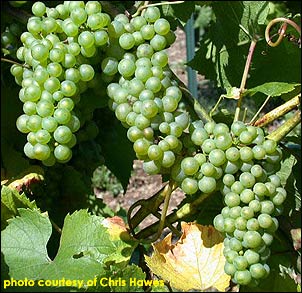 From Wikipedia,
From Wikipedia,the free encyclopedia
Wine is usually made from one or more varieties of the European species, Vitis vinifera. When one of these varieties, such as Pinot Noir, Chardonnay, or Merlot, for example, is used as the predominant grape (usually defined by law as a minimum of 75 or 85%) the result is a varietal, as opposed to a blended wine. Blended wines are in no way inferior to varietal wines; some of the world's most valued and expensive wines from the Bordeaux, Rioja or Tuscany regions, are a blend of several grape varieties of the same vintage.
Wine can also be made from other species or from hybrids, created by the genetic crossing of two species. Vitis labrusca, Vitis aestivalis, Vitis rupestris, Vitis rotundifolia and Vitis riparia are native North American grapes, usually grown for eating in fruit form or made into grape juice, jam, or jelly, but sometimes made into wine, eg. Concord wine (Vitis labrusca species).
Hybrids are not to be confused with the practice of grafting. Most of the world's vineyards are planted with European vinifera vines that have been grafted onto North American species rootstock. This is common practice because North American grape species are resistant to phylloxera. Grafting is done in every wine-producing country of the World except for Chile and Argentina, which have yet to be exposed to the insect.
The variety of grape(s), aspect (direction of slope), elevation, and topography of the vineyard, type and chemistry of soil, the climate and seasonal conditions under which grapes are grown, the local yeast cultures altogether form the concept of "terroir." The range of possibilities lead to great variety among wine products, which is extended by the fermentation, finishing, and aging processes. Many small producers use growing and production methods that preserve or accentuate the aroma and taste influences of their unique terroir.
However, flavor differences are not desirable for producers of mass-market table wine or other cheaper wines, where consistency is more important. Producers will try to minimize differences in sources of grapes by using wine making technology such as micro-oxygenation, tannin filtration, cross-flow filtration, thin film evaporation, and spinning cone.
No comments:
Post a Comment